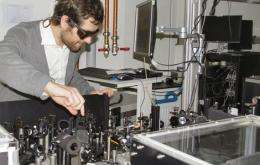Light touch transforms material into a superconductor

(�鶹��ԺOrg.com) -- A non-superconducting material has been transformed into a superconductor using light, Oxford University researchers report.
One hundred years after superconductivity was first observed in 1911, the team from Oxford, Germany and Japan observed conclusive signatures of superconductivity after hitting a non-superconductor with a strong burst of laser light.
‘We have used light to turn a normal insulator into a superconductor,’ says Professor Andrea Cavalleri of the Department of �鶹��Ժics at Oxford University and the Max Planck Department for Structural Dynamics, Hamburg. ‘That’s already exciting in terms of what it tells us about this class of materials. But the question now is can we take a material to a much higher temperature and make it a superconductor?’
The material the researchers used is closely related to high-temperature copper oxide superconductors, but the arrangement of electrons and atoms normally act to frustrate any electronic current.
In the journal Science, they describe how a strong infrared laser pulse was used to perturb the positions of some of the atoms in the material. The compound, held at a temperature just 20 degrees above absolute zero, almost instantaneously became a superconductor for a fraction of a second, before relaxing back to its normal state.
Superconductivity describes the phenomenon where an electric current is able to travel through a material without any resistance – the material is a perfect electrical conductor without any energy loss.
High-temperature superconductors can be found among a class of materials made up of layers of copper oxide, and typically superconduct up to a temperature of around –170°C. They are complex materials where the right interplay of the atoms and electrons is thought to ‘line up’ the electrons in a state where they collectively move through the material with no resistance.
‘We have shown that the non-superconducting state and the superconducting one are not that different in these materials, in that it takes only a millionth of a millionth of a second to make the electrons “synch up” and superconduct,’ says Professor Cavalleri. ‘This must mean that they were essentially already synched in the non-superconductor, but something was preventing them from sliding around with zero resistance. The precisely tuned laser light removes the frustration, unlocking the superconductivity.’
The advance immediately offers a new way to probe with great control how superconductivity arises in this class of materials, a puzzle ever since high-temperature superconductors were first discovered in 1986.
But the researchers are hopeful it could also offer a new route to obtaining superconductivity at higher temperatures. If superconductors that work at room temperature could be achieved, it would open up many more technological applications.
‘There is a school of thought that it should be possible to achieve superconductivity at much higher temperatures, but that some competing type of order in the material gets in the way,’ says Professor Cavalleri. ‘We should be able to explore this idea and see if we can disrupt the competing order to reveal superconductivity at higher temperatures. It’s certainly worth trying!’
Provided by Oxford University
















